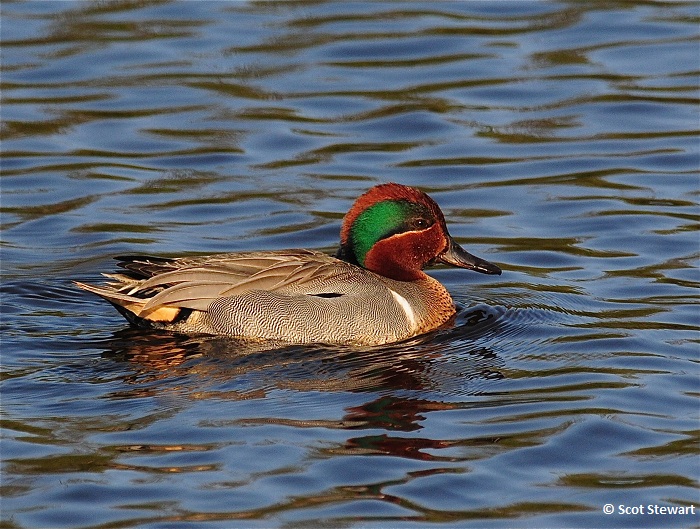What’s Flying: It’s a perfect time for seeing red

“October — the best time to be seeing red. Thank goodness for maple trees!” — Anonymous
Maple trees, at least the red, sugar, mountain, and yes even some boxelders are currently showing off all of this year’s popular shades of red, crimson, vermillion. As predicted, the colors of trees this year are often muted because of the drought conditions where they grow. The profusion of sunshine has produced a large amounts of anthocyanins, as red pigments in maples, sumacs and oaks as glucose sugar trapped in the leaves changes into these pigments. This year has produced a large number of maples with red-tipped leaves and other interesting color patterns. Color tour fans just have to look a little deeper into the woods in some areas to get a really spectacular view of fall.
Birding has been great too. Sandhill cranes have been massing together at staging areas across the eastern Upper Peninsula and beginning to head south for the winter. Their progress is a gradual one, with plenty of stops before they reach their winter homes in New Mexico or Florida. Some will stop in wetlands like the ones along Lake Michigan south of Peshtigo, Wisconsin, and many will spend an extended period this fall in the area around the Jasper Pulaski Wildlife Area about 60 miles southeast of Gary, Indiana. Up to 22,000 have spent past falls there before finally heading on to Florida and Bos de Apache National Wildlife Refuge in New Mexico.
Blue Jays and American crows have been a prominent part of the birding scene across some parts of the central U.P. all summer Their calls are frequent and loud, especially when noting the presence of raptors, owls or foxes hunting in their territories. Blue jay numbers have increased in the past several weeks as migrants wander through. Some jays and crows do stick around all winter but most move on to avoid greater depths of snow, where they can find more food. Crows seem to be peaking now as well. More than 50 were seen atop the south Marquette water tower this past Tuesday morning, making a huge racket as they appeared to maneuver and commune with a view from their spot on the tower.
Early duck and grebe migrants seem to mostly of the “through hiker” type, swiftly moving through the area on their migration southward. They are commonly seen first along major flight paths, like Whitefish Point, in early fall, but most commonly fly-bys. As the season progresses, some finally show up, usually in small numbers, in more visible locations like Lake Superior harbors in Marquette, and smaller bodies of water like lakes and sewage lagoons. They are showing up in those locations now across the area. Eventually they will get to their wintering grounds. Redheads have the largest winter range, nearly the entire southern two-thirds of the Lower 48 even into parts of Montana and most of Mexico. Lesser scaup occupy most of the southern half of the Lower 48 and most of the ocean coastlines up to Canada. Great scaup are found in large patches of the southern U.S. around major rivers, and areas the Pacific states and one that includes Montana and the surrounding states.
Winter grebes also have different plans for wintering. Smaller horned grebes may stay on Lake Superior until ice comes, then will head to the coasts and the southeastern states for winter.
Red-necked grebes have different plans, heading to Lake Erie and the slender shore of both the Atlantic and Pacific Coasts.
Some puddle ducks are making similar stops in the area too with both blue-winged and green-winged teals making visits to small area lakes and ponds. Last year a green-winged teal and an American wigeon spent most of the winter on the small pond behind Lambros Park, in the Dead River, and on Lake Superior, often with mallards.
While no one really knows why some birds stick around all winter when most head to warmer, foodier spots, there are some pros and cons. Food can be difficult to locate, and competition can be extreme — there can be 800-900 mallards and black ducks in the immediate Marquette area in the winter months. Colder temperatures require more calories.
For a weak or injured bird there be no other choice but to hang around and hope it can survive. Staying here though means no dangerous migration flights dealing with hunters, predators, and in-flight bad weather. It also means being able to arrive earlier in spring at better breeding territories, whether here or farther north for the summer. The decision is what natural selection is all about.
Some hawks also have to make the decision regarding staying or heading south. Sharp-shinned hawks occasionally spend the winter here, and often do well, spending time near bird feeders where there is plenty of traffic and feeding opportunities.
A sharp-shinned hawk, with bright red chest markings, was seen hunting over the mitigation ponds at Presque Isle last Friday. It sat perched in a maple there for a long time before diving down to the water for a drink, giving birders a great view of some behavior not often seen.
The shoreline and the open areas at Presque Isle and the practice fields around the roundabout at Wright and Lakeshore Boulevard have seen flocks of horned larks and the first large group of snow buntings this week, both items on sharp-shinned and peregrine falcon menus.
Seeing red takes on all sorts of meaning this time of year.
EDITOR’S NOTE: Scot Stewart is a teacher at Bothwell Middle School in Marquette and a freelance photographer.


